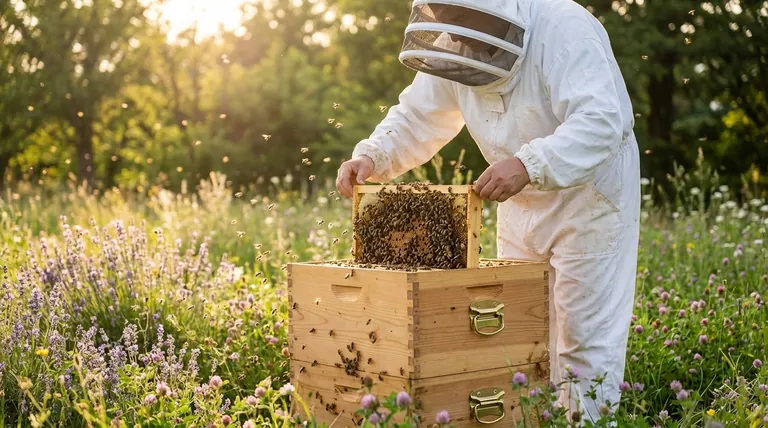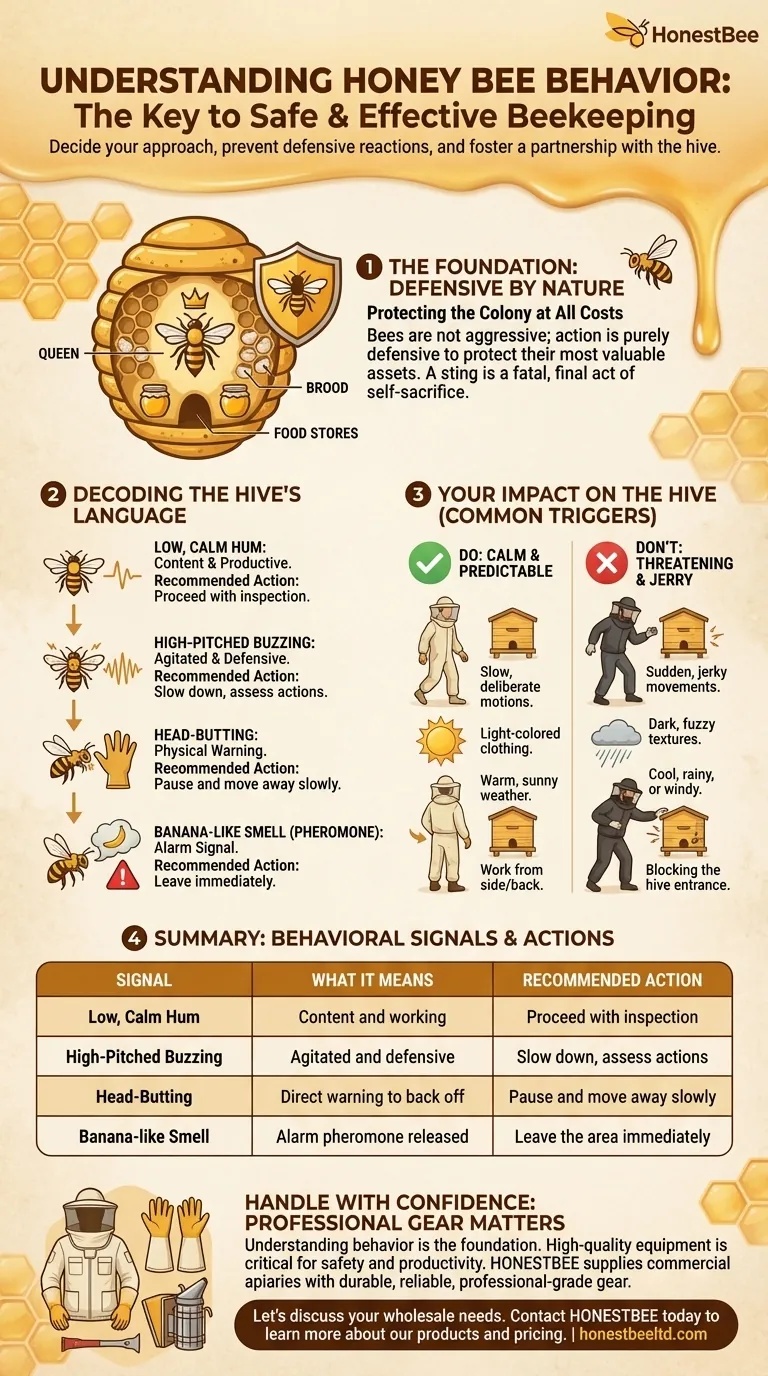Understanding honey bee behavior is the single most important factor in safe and effective beekeeping. It is the key to preventing defensive reactions before they start. Because bees only attack when they feel their colony is threatened, learning to interpret their signals allows you to handle them with a calmness and respect that they will mirror back to you.
The core principle is this: honey bees are not aggressive; they are defensive. Understanding their behavior is like learning a language—it transforms a potentially fearful interaction into a predictable and manageable partnership between you and the hive.

The Foundation: Defensive by Nature
The entire social structure of a honey bee colony is built on survival. Every action they take is for the good of the collective.
Protecting the Colony at All Costs
A bee's "attack" is a purely defensive act. They are protecting their three most valuable assets: the queen, the brood (developing bees), and their food stores (honey and pollen). They perceive a threat to any of these as a threat to their existence.
A Bee's Sting is a Final Act
For a honey bee, stinging a mammal is a fatal act of self-sacrifice. The barbed stinger remains in the skin, and the bee dies shortly after. This is not an action taken lightly; it is an absolute last resort to neutralize a perceived threat to the colony's survival.
Decoding the Hive's Language
A calm beekeeper is an observant one. The hive is constantly communicating its mood, and learning to recognize these signals is crucial.
The Baseline: A Calm Hum
The sound of a content, productive hive is a gentle, low-frequency hum. This is the noise of thousands of bees going about their daily work. This is the state you want to maintain.
The First Warning: A Change in Pitch
When bees become agitated, the pitch and volume of their buzzing will noticeably increase. A low hum that turns into a high-pitched "roar" is a clear sign that they are becoming defensive and that you should assess your actions.
The Physical Warning: Head-Butting
Before resorting to stinging, guard bees will often issue a physical warning. They will fly directly at your face mask or body and bump into you without attempting to sting. This is an unmistakable signal to "back off."
The Chemical Alarm: Pheromones
When a bee stings, it releases an alarm pheromone that smells like bananas or banana extract. This chemical signal alerts other bees to a specific threat, escalating the defensive response and marking you as a target.
Understanding the Trade-offs: Your Impact on the Hive
Your behavior has a direct and immediate impact on the colony's defensiveness. Understanding common triggers is non-negotiable.
Calm and Slow vs. Fast and Jerky
Sudden, jerky movements mimic the actions of a predator, like a bear tearing into a hive. Always use slow, deliberate, and gentle motions when working with your bees.
Light Colors vs. Dark Colors
Bees have evolved to see dark, fuzzy objects as potential threats (e.g., bears, skunks). Wearing light-colored, smooth-textured clothing is a simple way to appear less threatening.
Good Weather vs. Bad Weather
Bees are most docile on warm, sunny days during a nectar flow. On cool, rainy, or windy days, most foragers are stuck inside, making the hive feel crowded and defensive. Avoid hive inspections in poor weather if possible.
The Mistake of Blocking the Entrance
The hive entrance is a high-traffic runway. Standing directly in front of it blocks the flight path of thousands of bees, which is a major source of agitation. Always work from the side or the back of the hive.
Making the Right Choice for Your Goal
By understanding bee behavior, you shift from being an intruder to being a knowledgeable caretaker.
- If your primary focus is personal safety: Learn to recognize the early warnings—the change in sound and head-butting—so you can pause and de-escalate the situation before a single sting occurs.
- If your primary focus is hive health: Your calm, predictable handling minimizes stress on the colony, which allows them to focus their energy on foraging, raising brood, and storing honey.
- If your primary focus is overcoming fear: Reframe your mindset from fearing an "attack" to respecting a "defensive response," which puts you in control of the interaction.
Ultimately, your knowledge transforms beekeeping from a task of management into an act of cooperation.
Summary Table:
| Key Behavioral Signal | What It Means | Recommended Action |
|---|---|---|
| Low, Calm Hum | Bees are content and working. | Proceed with your inspection. |
| High-Pitched Buzzing | Bees are agitated and defensive. | Slow down, assess your actions. |
| Head-Butting | A direct warning to back off. | Pause and move away slowly. |
| Banana-like Smell | Alarm pheromone released from a sting. | Leave the area immediately. |
Ready to Handle Your Bees with Confidence?
Understanding bee behavior is the foundation of successful beekeeping. Having the right, high-quality equipment is just as critical for both your safety and your hive's productivity.
HONESTBEE supplies commercial apiaries and beekeeping equipment distributors with the durable, reliable supplies needed for safe and efficient hive management. From protective suits to smokers and hive tools, our wholesale-focused operations ensure you get the professional-grade gear your operation depends on.
Let's discuss your beekeeping supply needs. Contact HONESTBEE today to learn more about our products and wholesale pricing.
Visual Guide

Related Products
- Professional Grade Foldable Beehive Handles
- Heavy-Duty T-Style Frame Perch
- Professional Frame Comb Fork and Lifter for Efficient Handling
- Professional Galvanized Hive Strap with Secure Locking Buckle for Beekeeping
- Yellow Plastic Bucket Pail Perch for Beekeeping
People Also Ask
- What is a common hive setup in warmer regions? A Simple, Effective Guide for Healthy Bees
- Why is a bee brush important? Essential for Gentle, Safe Hive Management
- What equipment is needed to start beekeeping? Your Essential Guide to a Successful Apiary
- How does a beekeeper's demeanor affect the bees? Cultivate Calm for a Safer, More Productive Hive
- How can beekeepers remember the timeline of bee development from egg to pupa? Use the 3-6-12 Rule.



















